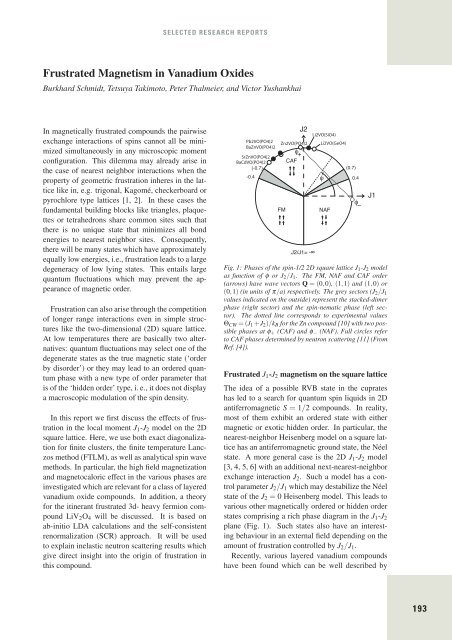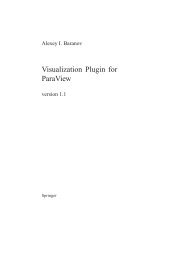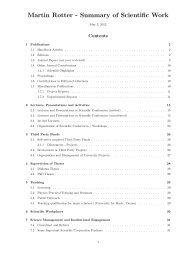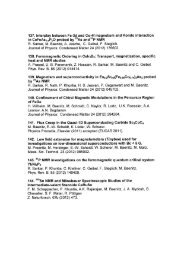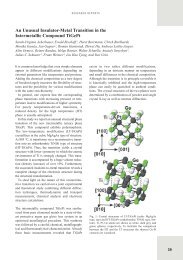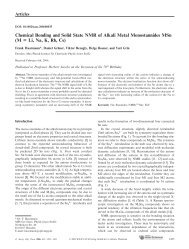Frustrated Magnetism in Vanadium Oxides
Frustrated Magnetism in Vanadium Oxides
Frustrated Magnetism in Vanadium Oxides
You also want an ePaper? Increase the reach of your titles
YUMPU automatically turns print PDFs into web optimized ePapers that Google loves.
<strong>Frustrated</strong> <strong>Magnetism</strong> <strong>in</strong> <strong>Vanadium</strong> <strong>Oxides</strong><br />
Burkhard Schmidt, Tetsuya Takimoto, Peter Thalmeier, and Victor Yushankhai<br />
In magnetically frustrated compounds the pairwise<br />
exchange <strong>in</strong>teractions of sp<strong>in</strong>s cannot all be m<strong>in</strong>imized<br />
simultaneously <strong>in</strong> any microscopic moment<br />
configuration. This dilemma may already arise <strong>in</strong><br />
the case of nearest neighbor <strong>in</strong>teractions when the<br />
property of geometric frustration <strong>in</strong>heres <strong>in</strong> the lattice<br />
like <strong>in</strong>, e.g. trigonal, Kagomé, checkerboard or<br />
pyrochlore type lattices [1, 2]. In these cases the<br />
fundamental build<strong>in</strong>g blocks like triangles, plaquettes<br />
or tetrahedrons share common sites such that<br />
there is no unique state that m<strong>in</strong>imizes all bond<br />
energies to nearest neighbor sites. Consequently,<br />
there will be many states which have approximately<br />
equally low energies, i.e., frustration leads to a large<br />
degeneracy of low ly<strong>in</strong>g states. This entails large<br />
quantum fluctuations which may prevent the appearance<br />
of magnetic order.<br />
Frustration can also arise through the competition<br />
of longer range <strong>in</strong>teractions even <strong>in</strong> simple structures<br />
like the two-dimensional (2D) square lattice.<br />
At low temperatures there are basically two alternatives:<br />
quantum fluctuations may select one of the<br />
degenerate states as the true magnetic state (‘order<br />
by disorder’) or they may lead to an ordered quantum<br />
phase with a new type of order parameter that<br />
is of the ‘hidden order’ type, i. e., it does not display<br />
a macroscopic modulation of the sp<strong>in</strong> density.<br />
In this report we first discuss the effects of frustration<br />
<strong>in</strong> the local moment J1-J2 model on the 2D<br />
square lattice. Here, we use both exact diagonalization<br />
for f<strong>in</strong>ite clusters, the f<strong>in</strong>ite temperature Lanczos<br />
method (FTLM), as well as analytical sp<strong>in</strong> wave<br />
methods. In particular, the high field magnetization<br />
and magnetocaloric effect <strong>in</strong> the various phases are<br />
<strong>in</strong>vestigated which are relevant for a class of layered<br />
vanadium oxide compounds. In addition, a theory<br />
for the it<strong>in</strong>erant frustrated 3d- heavy fermion compound<br />
LiV2O4 will be discussed. It is based on<br />
ab-<strong>in</strong>itio LDA calculations and the self-consistent<br />
renormalization (SCR) approach. It will be used<br />
to expla<strong>in</strong> <strong>in</strong>elastic neutron scatter<strong>in</strong>g results which<br />
give direct <strong>in</strong>sight <strong>in</strong>to the orig<strong>in</strong> of frustration <strong>in</strong><br />
this compound.<br />
SELECTED RESEARCH REPORTS<br />
Fig. 1: Phases of the sp<strong>in</strong>-1/2 2D square lattice J1-J2 model<br />
as function of φ or J2/J1. The FM, NAF and CAF order<br />
(arrows) have wave vectors Q =(0,0), (1,1) and (1,0) or<br />
(0,1) (<strong>in</strong> units of π/a) respectively. The grey sectors (J2/J1<br />
values <strong>in</strong>dicated on the outside) represent the stacked-dimer<br />
phase (right sector) and the sp<strong>in</strong>-nematic phase (left sector).<br />
The dotted l<strong>in</strong>e corresponds to experimental values<br />
ΘCW =(J1 +J2)/kB for the Zn compound [10] with two possible<br />
phases at φ+ (CAF) and φ− (NAF). Full circles refer<br />
to CAF phases determ<strong>in</strong>ed by neutron scatter<strong>in</strong>g [11] (From<br />
Ref. [4]).<br />
<strong>Frustrated</strong> J1-J2 magnetism on the square lattice<br />
The idea of a possible RVB state <strong>in</strong> the cuprates<br />
has led to a search for quantum sp<strong>in</strong> liquids <strong>in</strong> 2D<br />
antiferromagnetic S = 1/2 compounds. In reality,<br />
most of them exhibit an ordered state with either<br />
magnetic or exotic hidden order. In particular, the<br />
nearest-neighbor Heisenberg model on a square lattice<br />
has an antiferromagnetic ground state, the Néel<br />
state. A more general case is the 2D J1-J2 model<br />
[3, 4, 5, 6] with an additional next-nearest-neighbor<br />
exchange <strong>in</strong>teraction J2. Such a model has a control<br />
parameter J2/J1 which may destabilize the Néel<br />
state of the J2 = 0 Heisenberg model. This leads to<br />
various other magnetically ordered or hidden order<br />
states compris<strong>in</strong>g a rich phase diagram <strong>in</strong> the J1-J2<br />
plane (Fig. 1). Such states also have an <strong>in</strong>terest<strong>in</strong>g<br />
behaviour <strong>in</strong> an external field depend<strong>in</strong>g on the<br />
amount of frustration controlled by J2/J1.<br />
Recently, various layered vanadium compounds<br />
have been found which can be well described by<br />
193
194<br />
the J1-J2 model. They are of the type Li2VOXO4<br />
(X = Si, Ge) [8] and AA ′ VO(PO4)2 (A, A ′ = Pb,<br />
Zn, Sr, Ba) [9, 10] and consist of V-oxide pyramid<br />
layers conta<strong>in</strong><strong>in</strong>g V 4+ ions with S = 1/2. From<br />
the analysis of the zero-field thermodynamics like<br />
specific heat and susceptibility the frustration ratio<br />
J2/J1 may be obta<strong>in</strong>ed. However, an ambiguity rema<strong>in</strong>s<br />
[3] which can be resolved by diagnos<strong>in</strong>g the<br />
high-field behaviour discussed below.<br />
The 2D square lattice J1-J2 model <strong>in</strong> a magnetic<br />
field is given by<br />
H = J1 ∑ Si.S j + J2 ∑ Si.S j − h∑<br />
〈ij〉1<br />
〈ij〉2<br />
i<br />
S z i<br />
. (1)<br />
Here J1 and J2 are the two exchange constants per<br />
bond between nearest and next nearest neighbors on<br />
a square lattice, respectively, and h = gμBH where<br />
g is the gyromagnetic ratio, μB the Bohr magneton,<br />
and H the magnetic field density. The phase<br />
diagram is preferably characterized by <strong>in</strong>troduc<strong>in</strong>g<br />
equivalent parameters Jc =(J 2 1 + J2 2 ) 1 2 and the frustration<br />
angle φ = tan −1 (J2/J1).<br />
This model has three possible classical magnetic<br />
ground states (see Fig. 1) depend<strong>in</strong>g on φ: Ferromagnet<br />
(FM), Néel antiferromagnet (NAF) and<br />
coll<strong>in</strong>ear antiferromagnet (CAF) [3]. The <strong>in</strong>fluence<br />
of exchange frustration lead<strong>in</strong>g to enhanced quantum<br />
fluctuations is strongest at the classical phase<br />
boundaries where the CAF phase jo<strong>in</strong>s the NAF (<br />
J2/J1 = 0.5, φ ≈−0.15π) orFM(J2/J1 = −0.5,<br />
φ ≈ 0.85π) phases. In fact, <strong>in</strong> these regions they<br />
destroy long-range magnetic order [3] and establish<br />
two new ordered states, namely a gapped columnar<br />
dimer state at the CAF/NAF boundary and a gapless<br />
sp<strong>in</strong> nematic state at the CAF/FM boundary [5] as<br />
shown by the grey sectors <strong>in</strong> Fig. 1.<br />
Specific heat and susceptibility, also <strong>in</strong> f<strong>in</strong>ite<br />
field, may be calculated for f<strong>in</strong>ite clusters us<strong>in</strong>g the<br />
FTLM method to evalutate their respective cumulant<br />
expressions [3]. Fig. 2 shows the field dependence<br />
of CV (T,H) as a function of the frustration<br />
angle φ at constant temperature T = 0.2Jc/kB. The<br />
heat capacity is large <strong>in</strong> the disordered regions reflect<strong>in</strong>g<br />
the high number of quasi-degenerate states.<br />
Around J2/J1 = 1/2 (φ/π ≈ 0.15), a two-ridge<br />
structure evolves with <strong>in</strong>creas<strong>in</strong>g field. Due to the<br />
smallness of the saturation field, we currently cannot<br />
decide whether such a structure also exists at<br />
the “mirrored” (J2 →−J2) position <strong>in</strong> the phase diagram<br />
at J2/J1 = −1/2. When reach<strong>in</strong>g the saturation<br />
field, the heat capacity drops and eventually<br />
vanishes due to the gap open<strong>in</strong>g.<br />
SELECTED RESEARCH REPORTS<br />
gμ B H / J c<br />
Fig. 2: Contour plot of the heat capacity for the 24-site cluster<br />
at a fixed temperature T = 0.2Jc/kB as a function of the<br />
frustration angle φ and the magnetic field density H.<br />
Χ Jc ��N A Μ 0 g 2 Μ B 2 �<br />
6<br />
5<br />
4<br />
3<br />
2<br />
1<br />
FM NAF CAF FM<br />
0<br />
–1 –0.5 0<br />
/<br />
0.5 1<br />
0.25<br />
0.20<br />
0.15<br />
0.10<br />
0.05<br />
C V / (N Ak B )<br />
0.05<br />
0.00<br />
0 2 4 6 8 10<br />
kB T � Jc<br />
Fig. 3: Temperature dependence of the magnetic susceptibility<br />
of BaCdVO(PO4)2. Dots denote the experimental result<br />
[7], the two curves denote a Curie-Weiss fit to the hightemperature<br />
part (dashed l<strong>in</strong>e) and a fit us<strong>in</strong>g our f<strong>in</strong>itetemperature<br />
Lanczos data (solid l<strong>in</strong>e).<br />
The magnetic susceptibility and the magnetization<br />
at low temperatures of the new compound<br />
BaCdVO(PO4)2 have been measured [7]. Fig. 3<br />
displays a plot of the temperature dependence of<br />
the magnetic susceptibility (dots) and a Curie-Weiss<br />
fit applied to the high-temperature part of the data<br />
(dashed l<strong>in</strong>e; 20K ≤ T ≤ 300K). In addition, we<br />
have conducted a series of fits us<strong>in</strong>g our FTLM data<br />
calculated on a 24-site cluster [4]. The best fit is<br />
plotted <strong>in</strong> Fig. 3 (solid l<strong>in</strong>e). From this, we obta<strong>in</strong>ed<br />
a frustration angle φ = 0.77π and an effective exchange<br />
Jc = 4.8K. (The latter was used to normalize<br />
the experimental data for the plot.) This result is<br />
<strong>in</strong> excellent agreement with Ref. [7], where a hightemperature<br />
series expansion was used to determ<strong>in</strong>e<br />
the exchange constants.<br />
Investigation of the uniform magnetization leads<br />
to a further understand<strong>in</strong>g of the possible ground<br />
states of the model [6]. It may be obta<strong>in</strong>ed both<br />
0.3<br />
0.25<br />
0.2<br />
0.15<br />
0.1<br />
0
μ / μ B<br />
2<br />
1.5<br />
1<br />
0.5<br />
0<br />
6<br />
5<br />
4<br />
h s / J c<br />
3<br />
2<br />
1<br />
/<br />
0<br />
FM NAF CAF FM<br />
–1<br />
-1.0 -0.5 0.0 0.5 1.0<br />
0.75<br />
0 0.2 0.4 0.6<br />
H / Hsat 0.8 1 1.2<br />
Fig. 4: Magnetization curves μ/μB = gm (= m/S) for various<br />
φ <strong>in</strong> the AF or disordered sectors (each curve offset by<br />
0.2). Symbols: T = 0 Lanczos results for N = 16 (squares),<br />
20 (diamonds), 24 (dots, circles) size clusters. L<strong>in</strong>es: first<br />
order sp<strong>in</strong> wave calculations. φ/π = 0.75, −0.21 correspond<br />
to the possible CAF or NAF values of the Sr compound.<br />
Magnetization curves strongly differ <strong>in</strong> the extent<br />
of nonl<strong>in</strong>ear deviation from the classical curve which corresponds<br />
to φ/π = −0.5. Deep <strong>in</strong>side CAF or NAF regions the<br />
agreement of sp<strong>in</strong> wave and Lanczos calculations is good.<br />
The values φ/π = 0.75, 0.17 are nearby or with<strong>in</strong> the nonmagnetic<br />
sectors. At the CAF/NAF boundary the numerical<br />
data exhibit a plateau with m/S = μ/μB = 0.5 due to<br />
three-magnon bound states. Lower <strong>in</strong>set shows the position<br />
of plotted φ values <strong>in</strong> the phase diagram. Upper <strong>in</strong>set exhibits<br />
the saturation field as function of φ (hs ≡ gμBHsat).<br />
(From Ref. [6]).<br />
from numerical Lanczos calculations as well as analytical<br />
sp<strong>in</strong> wave expansion start<strong>in</strong>g from the three<br />
magnetic phases. In the latter approach the harmonic<br />
sp<strong>in</strong> wave Hamiltonian is<br />
H = NE0 + NEZP +∑ k<br />
classical<br />
εk(h)α †<br />
kαk , (2)<br />
where α †<br />
k creates magnons with a dispersion<br />
εk(h)=S(ak + ck) 1 2 (ak + ck cosθc) 1 2 . (3)<br />
With γk = 1 2 (coskx + cosky) and ¯γk = coskx cosky,<br />
SELECTED RESEARCH REPORTS<br />
/ = 0.75<br />
0.41<br />
0.17<br />
-0.17<br />
-0.21<br />
0.41<br />
0.17<br />
-0.17<br />
-0.21<br />
the <strong>in</strong>tra- and <strong>in</strong>tersublattice <strong>in</strong>teractions are given<br />
by ak = 4[J1 − J2(1 − ¯γk)] and ck = −bk = 4J1γk,<br />
respectively, for the NAF and by similar expressions<br />
for the CAF [6]. The field-<strong>in</strong>duced cant<strong>in</strong>g angle<br />
θc of sublattice moments (with respect to the field<br />
direction) decreases from θc = π 2 to θc = 0 when<br />
the field <strong>in</strong>creases form zero to the saturation field<br />
hs(Jc,φ) (see upper <strong>in</strong>set of Fig. 4).<br />
The ‘classical’ cant<strong>in</strong>g angle obta<strong>in</strong>ed from m<strong>in</strong>imization<br />
of E0(h,θc) is given by cos θc<br />
2 = h/hs result<strong>in</strong>g<br />
<strong>in</strong> a l<strong>in</strong>ear magnetization m0 = S(h/hs). This<br />
will be changed by the effect of zero po<strong>in</strong>t fluctuations<br />
which have an energy<br />
EZP = 1<br />
2N ∑[εk(h) − Sak] . (4)<br />
k<br />
The associated quantum corrections <strong>in</strong> the magnetization<br />
modify the l<strong>in</strong>ear classical behavior with<br />
a correction term mZP = −∂EZP(h)/∂h. Itisdeterm<strong>in</strong>ed<br />
by the dispersion εk(h) which becomes<br />
very anomalous at the classical phase boundaries<br />
CAF/NAF and CAF/FM [3]: The expression for the<br />
magnetization <strong>in</strong>clud<strong>in</strong>g quantum corrections up to<br />
order 1/S is given by [6]<br />
m = S h<br />
�<br />
1 −<br />
hs<br />
1 1<br />
hs N ∑ � ak + ck � 1 �<br />
2<br />
ck<br />
. (5)<br />
k<br />
ak + ck cosθc<br />
Because hs ∼ S the second term <strong>in</strong> Eq. (5) is formally<br />
a 1/S correction to the l<strong>in</strong>ear classical term<br />
m0 = S(h/hs). These corrections depend on the degree<br />
of frustration measured by φ. In the strongly<br />
frustrated regime around the classical phase boundaries<br />
the dispersion becomes flat along l<strong>in</strong>es <strong>in</strong> the<br />
BZ [3]. Thus, there is a dramatic <strong>in</strong>crease of the<br />
phase space for quantum fluctuations lead<strong>in</strong>g to<br />
strong nonl<strong>in</strong>ear corrections for the magnetization<br />
(Fig. 4). With<strong>in</strong> the grey sectors of Fig. 1 magnetic<br />
order breaks down and quantum fluctuations stabilize<br />
sp<strong>in</strong>-nematic (left) and stacked-dimer (right)<br />
hidden order parameters.<br />
Fig. 5 presents a plot of the experimental magnetization<br />
data [7], marked as open circles, and a<br />
plot of data derived from exact diagonalization (full<br />
symbols). The latter are determ<strong>in</strong>ed from the zerotemperature<br />
field dependence of the magnetization<br />
for tiles of N = 16 (squares), N = 20 (diamonds),<br />
and N = 24 sites (dots). Except for low magnetic<br />
fields, and tak<strong>in</strong>g <strong>in</strong>to account the f<strong>in</strong>ite-temperature<br />
round<strong>in</strong>g of the experimental data around the saturation<br />
field, the agreement with experiment is, aga<strong>in</strong>,<br />
excellent. From our values for Jc and φ stated<br />
195
196<br />
Fig. 5: Nonl<strong>in</strong>ear magnetization curves due to quantum<br />
fluctuations both from experiment and theory (ED) with<br />
φ/π = 0.77 for the BaCd-compound. It is closest to the sp<strong>in</strong>nematic<br />
sector <strong>in</strong> Fig. 1.<br />
above, we get a saturation field Hsat = 4.1T, compared<br />
to H exp<br />
sat = 4.2T from Ref. [7]. The latter value<br />
gives a clear <strong>in</strong>dication that BaCdVO(PO4)2, like<br />
Pb2VO(PO4)2, is a coll<strong>in</strong>ear antiferromagnet s<strong>in</strong>ce<br />
for the Néel phase, accord<strong>in</strong>g to the <strong>in</strong>set of Fig. 4,<br />
the saturation field would be more than 50% higher,<br />
namely HNAF sat ≈ 6.5T.<br />
F<strong>in</strong>ite-size effects may play a role for the deviations<br />
of the two curves at low fields H ≤ 0.4Hsat:<br />
Experimentally, a l<strong>in</strong>ear, classical field dependence<br />
is observed at the lowest fields, whereas the f<strong>in</strong>itesize<br />
gap and the correspond<strong>in</strong>g Zeeman splitt<strong>in</strong>g<br />
of the ground-state doublet determ<strong>in</strong>es the nonl<strong>in</strong>ear<br />
field dependence of the numerical values. We<br />
note that for a value φ = 0.77π (Fig. 5) close to the<br />
CAF <strong>in</strong>stability a sp<strong>in</strong> wave calculation for M(H)<br />
no longer converges for small H [6]. S<strong>in</strong>ce the fully<br />
polarized state is an eigenstate of the Hamiltonian,<br />
f<strong>in</strong>ite size effects do not play a crucial role near the<br />
saturation field.<br />
Further <strong>in</strong>sight <strong>in</strong>to the quantum phases of the J1-<br />
J2 model and its high-field behavior may be ga<strong>in</strong>ed<br />
from magnetocaloric properties [4]. The magnetocaloric<br />
coefficient Γmc(h) (the adiabatic cool<strong>in</strong>g<br />
rate) has a sharp anomaly from which hs may be<br />
obta<strong>in</strong>ed. It is def<strong>in</strong>ed as the rate of adiabatic temperature<br />
change with external field:<br />
� �<br />
∂T<br />
Γmc ≡ = −<br />
∂H S<br />
T<br />
CV<br />
� �<br />
∂m<br />
∂T H<br />
. (6)<br />
In a paramagnet one has Γ 0 mc =(T /H). Therefore,<br />
ˆΓmc = Γmc/Γ 0 mc is the magnetocaloric enhancement<br />
due to sp<strong>in</strong> <strong>in</strong>teraction effects. For the<br />
SELECTED RESEARCH REPORTS<br />
gμ B H / J c<br />
6<br />
4<br />
2<br />
FM NAF CAF FM<br />
0<br />
–1 –0.5 0<br />
/<br />
0.5 1<br />
T/ H / (gμ B/k B)<br />
0.8<br />
0.6<br />
0.4<br />
0.2<br />
0<br />
–0.2<br />
–0.4<br />
Fig. 6: Contour plot of the normalized magnetocaloric effect<br />
Γmc/(T /H) for the 24-site cluster at a fixed temperature T =<br />
0.2Jc/kB as a function of the frustration angle φ and the<br />
magnetic field H.<br />
J1-J2 model, Γ 0 mc may be aga<strong>in</strong> calculated numerically<br />
for f<strong>in</strong>ite clusters with the cumulant expression<br />
� � ��<br />
∂T T<br />
∂H S H<br />
−gμBH<br />
�<br />
=<br />
� H S tot<br />
z<br />
� � �<br />
− 〈H 〉 Stot z<br />
〈H 2 〉 − 〈H 〉 2 . (7)<br />
In Fig. 6, a contour plot of the normalized magnetocaloric<br />
effect as a function of the applied field h<br />
and the frustration angle φ is shown. The magnetocaloric<br />
enhancement ratio <strong>in</strong> FTLM and sp<strong>in</strong> wave<br />
approximation (us<strong>in</strong>g Eqs. (5, 6)) exhibit qualitatively<br />
similar features: A strong upturn and a positive<br />
peak just above the saturation field hs as well<br />
as for T ≪ Jc/kB a negative coefficient immediately<br />
below hs [4].<br />
It is <strong>in</strong>structive to consider the dependence of<br />
ˆΓmc(h = hs;φ) on the frustration angle keep<strong>in</strong>g the<br />
field at saturation level where the maximum of Γmc<br />
occurs. Note that the specific heat CV (T,H) (Fig. 2)<br />
occurs <strong>in</strong> the denom<strong>in</strong>ator of Eq. (6). It shows a<br />
strong enhancement close-by and <strong>in</strong> the quantum<br />
phase regions (φ � 0.15π,φ � 0.85π) due to large<br />
degeneracy. This overcompensates the simultaneous<br />
<strong>in</strong>crease of the numerator <strong>in</strong> Eq. (6). Therefore,<br />
the magnetocaloric enhancement ˆΓmc is only<br />
moderate <strong>in</strong> these regions while its maxima occur<br />
<strong>in</strong> the middle of the NAF or CAF phase sectors of<br />
Fig. 1. The measurement of Γmc(h) should be an<br />
excellent method to determ<strong>in</strong>e the saturation fields<br />
Hsat <strong>in</strong> the J1-J2 compounds. Their absolute values<br />
for the known layered V-oxides range from 5 to<br />
25 T [4].
Fig. 7: Top (a): Static sp<strong>in</strong> susceptibility χ(Q,0) along<br />
[111] direction for different values of local exchange coupl<strong>in</strong>g<br />
constant K < Kc (K = 0.45, 0.40, 0.30 from top to<br />
bottom). The critical exchange coupl<strong>in</strong>g is Kc = 0.49eV and<br />
2π/a � 0.76Å−1 . (From Ref. [13]). Bottom (b): Static susceptibilities<br />
at q = Qc (full circles) and q = 0 (open circles)<br />
as functions of temperature observed <strong>in</strong> INS and magnetic<br />
measurements on LiV2O4 respectively. The solid l<strong>in</strong>e is a<br />
fit to χ(Qc,T ) us<strong>in</strong>g the self-consistent solution of yQc (T ).<br />
(From Ref. [14]).<br />
It<strong>in</strong>erant frustrated heavy fermion compound<br />
LiV2O4<br />
The metallic sp<strong>in</strong>el compound LiV2O4 is the first<br />
3d- heavy electron system discovered [12]. Below<br />
30K, a large specific heat and Pauli susceptibility<br />
enhancement appears, the former yields γ =<br />
C/T = 0.4J/(mol K 2 ) at the lowest temperatures.<br />
Many proposals to expla<strong>in</strong> this behavior have been<br />
put forward, <strong>in</strong>clud<strong>in</strong>g traditional Kondo-like scenarios.<br />
A special feature of the sp<strong>in</strong>els and, therefore,<br />
of LiV2O4 is the fact that V atoms reside on<br />
a pyrochlore lattice. Their average electron count<br />
is nd = 1.5 per V correspond<strong>in</strong>g to quarter-fill<strong>in</strong>g<br />
(<strong>in</strong> the hole picture) of d-bands, i.e., the system<br />
is far from the localized Mott limit. With<strong>in</strong> RPA<br />
sp<strong>in</strong> fluctuation theory based on ab-<strong>in</strong>itio LDA electronic<br />
structure calculations it was found that pronounced<br />
short-range sp<strong>in</strong> correlations <strong>in</strong> the paramagnetic<br />
metallic state of LiV2O4 appear.<br />
SELECTED RESEARCH REPORTS<br />
The result of this calculation [13] for various subcritical<br />
exchange strengths is depicted <strong>in</strong> Fig. 7 for<br />
the [111]-direction <strong>in</strong> q-space. Together with results<br />
for [100] and [110] it shows that the susceptibility<br />
is enhanced by approximately the same factor <strong>in</strong><br />
a critical shell, which is a nearly spherical region<br />
with a radius Qc � 0.6Å −1 and a f<strong>in</strong>ite thickness<br />
δQ � 0.45Å −1 <strong>in</strong> momentum space. This is the signature<br />
of frustration for it<strong>in</strong>erant sp<strong>in</strong>-fluctuations.<br />
S<strong>in</strong>ce the static χ(Q) � χ(Qc) is almost degenerate<br />
<strong>in</strong> this shell, the system, although close to a magnetic<br />
<strong>in</strong>stability, has no obvious way to select an<br />
order<strong>in</strong>g wave vector. As a consequence, the dynamical<br />
susceptibility resonds with slow<strong>in</strong>g down<br />
(shift<strong>in</strong>g the spectral function weight to very low energies)<br />
<strong>in</strong> the whole critical shell <strong>in</strong> the BZ. Therefore,<br />
there is a large phase space of low energy sp<strong>in</strong><br />
fluctuations which can renormalize the quasiparticle<br />
mass. This situation is quite different from nonfrustrated<br />
lattices <strong>in</strong> which the enhancement of the<br />
<strong>in</strong>teract<strong>in</strong>g susceptibility is usually sharply peaked<br />
around the <strong>in</strong>cipient magnetic order<strong>in</strong>g vector, provid<strong>in</strong>g<br />
only a small phase space and moderate quasiparticle<br />
mass enhancement.<br />
When Q is located with<strong>in</strong> the critical shell the dynamical<br />
susceptibility for low energy sp<strong>in</strong> fluctuations<br />
is (Q = |Q|)<br />
Im χ(Q,ω) � zQχ(Q)ω/Γ(Q) , (8)<br />
where Γ(Q) and zQ < 1 are their energy width and<br />
weight, respectively. S<strong>in</strong>ce χ(Q) is much enhanced<br />
and Γ(Q) small <strong>in</strong> the critical shell the spectral<br />
function around Qc is strongly peaked at low energies,<br />
<strong>in</strong> agreement with <strong>in</strong>elastic neutron scatter<strong>in</strong>g<br />
(INS) results [16, 17]. The conduction electrons are<br />
dressed with these low energy bosons lead<strong>in</strong>g to a<br />
large sp<strong>in</strong> fluctuation specific heat γsf = Csf/T below<br />
60 K given by<br />
γsf = k2 B π<br />
N ∑ q<br />
z(q)<br />
. (9)<br />
¯hΓ(q)<br />
S<strong>in</strong>ce Γ(q) is small <strong>in</strong> the whole critical shell around<br />
|q| = Qc this may lead to a large γsf. The absolute<br />
scale of the sp<strong>in</strong> fluctuation width Γ is estimated to<br />
fall between 0.5meV < Γ < 1.5meV with a correspond<strong>in</strong>g<br />
γsf rang<strong>in</strong>g between 100 and 300 <strong>in</strong> units<br />
of mJ/(K 2 mol). This proves that slow sp<strong>in</strong> fluctuations<br />
over an extended momentum region, due to<br />
frustration, may expla<strong>in</strong> the size of the large γ value<br />
<strong>in</strong> LiV2O4 and its heavy-fermion character.<br />
At higher temperatures the sp<strong>in</strong> fluctuation modes<br />
of different q are coupled lead<strong>in</strong>g to a transfer of<br />
197
198<br />
spectral weight from the critical region to the lowmomentum<br />
region. Experimentally it was observed<br />
that above 60 K the susceptibility enhancement <strong>in</strong><br />
the critical shell around q = Qc vanishes and becomes<br />
equal to the value at q = 0. The effect of<br />
mode coupl<strong>in</strong>g on the static susceptibility is described<br />
with<strong>in</strong> Moriya’s self- consistent renormalization<br />
(SCR) theory [18]. With b(ω)=1/(e ω/T −<br />
1) one f<strong>in</strong>ds<br />
1<br />
χ(q)T<br />
= 1<br />
+<br />
χ(q)0<br />
¯FQc<br />
� ∞ dω<br />
N 0 2π b(ω)∑ Im χ(q<br />
q ′<br />
′ ,ω).<br />
(10)<br />
Here, ¯FQc is a mode-mode coupl<strong>in</strong>g constant for<br />
the critical shell. The reduced <strong>in</strong>verse susceptibility<br />
may be written as y(Qc,T )=1 � (2TAχQc (T ))<br />
where TA � 220K is a scal<strong>in</strong>g parameter. It is obta<strong>in</strong>ed<br />
from a numerical solution of the SCR <strong>in</strong>tegral<br />
equation derived from Eq. (10) [14, 15]. The<br />
result<strong>in</strong>g temperature dependence of the critical susceptibility<br />
χQc (T ) together with correspond<strong>in</strong>g experimental<br />
results and those of q = 0 are presented<br />
<strong>in</strong> Fig. 7b. It demonstrates that the critical enhancement<br />
of χQc (T ) is rapidly reduced with temperature<br />
and approaches the value of the FM po<strong>in</strong>t q = 0.<br />
S<strong>in</strong>ce the ratio of scatter<strong>in</strong>g <strong>in</strong>tensities at q = Qc and<br />
q = 0 is proportional to the square of the susceptibilities,<br />
Fig. 7b implies that the critical scatter<strong>in</strong>g <strong>in</strong>tensity<br />
at Qc is reduced by almost a factor 16 when<br />
the temperature <strong>in</strong>creases to 60 K. Recently it was<br />
shown [15] that SCR theory can also expla<strong>in</strong> the<br />
temperature and pressure dependence of the NMR<br />
relaxation rate <strong>in</strong> LiV2O4 sufficiently far from the<br />
quantum critical po<strong>in</strong>t where a yet unidentified order<br />
appears. Further <strong>in</strong>vestigations on the behavior<br />
of the resistivity of this compound are <strong>in</strong> progress.<br />
SELECTED RESEARCH REPORTS<br />
References<br />
[1] G. Misguich and C. Lhuillier <strong>in</strong> <strong>Frustrated</strong> Sp<strong>in</strong> Systems<br />
ed. by H. T. Diep , World Scientific, S<strong>in</strong>gapore,<br />
2004.<br />
[2] P. Fulde, P. Thalmeier, and G. Zwicknagl, Solid State<br />
Physics 60 (2006) 1.<br />
[3] N. Shannon, B. Schmidt, K. Penc, and P. Thalmeier,<br />
Eur. Phys. J. B 38 (2004) 599.<br />
[4] B. Schmidt, P. Thalmeier, and N. Shannon, Phys. Rev.<br />
B 76 (2007) 125113.<br />
[5] N. Shannon, T. Momoi, and P. S<strong>in</strong>dz<strong>in</strong>gre, Phys. Rev.<br />
Lett. 96 (2006) 027213.<br />
[6] P. Thalmeier, M. Zhitomirsky, B. Schmidt, and N. Shannon,<br />
Phys. Rev. B 77 (2008) 104441.<br />
[7] R. Nath, A. A. Tsirl<strong>in</strong>, H. Rosner, and C. Geibel, Phys.<br />
Rev. B 78 (2008) 064422.<br />
[8] R. Melzi, S. Aldrovandi, F. Teboldi, P. Carretta, P. Millet,<br />
and F. Mila, Phys. Rev. B 64 (2001) 024409.<br />
[9] E. E. Kaul, H. Rosner, N. Shannon, R. V. Shpanchenko,<br />
and C. Geibel, J. Magn. Magn. Mat. 272-276 (2004)<br />
922.<br />
[10] N. K<strong>in</strong>i, E. E. Kaul, and C. Geibel, J. Phys.: Cond. Mat.<br />
18 (2006) 1303.<br />
[11] M. Skoulatos, J. P. Goff, N. Shannon, E. Kaul, C.<br />
Geibel, a. P. Murani, M. Enderle, and A. R. Wildes,<br />
J. Magn. Magn. Mat. 310 (2007) 1257.<br />
[12] S. Kondo et al, Phys. Rev. Lett. 78 (1997) 3729.<br />
[13] V. Yushankhai, A. Yaresko, P. Fulde, and P. Thalmeier,<br />
Phys. Rev. B 76 (2007) 085111.<br />
[14] V. Yushankhai, P. Thalmeier, and T. Takimoto, Phys.<br />
Rev. B 77 (2008) 094438.<br />
[15] V. Yushankhai, T. Takimoto, and P. Thalmeier, J. Phys.:<br />
Cond. Mat. 20 (2008) 465221.<br />
[16] A. Krimmel, A. Loidl, M. Klemm, S. Horn, and H.<br />
Schober, Phys. Rev. Lett. 82 (1999) 2919.<br />
[17] S. H. Lee, Y. Qiu, C. Broholm, Y. Ueda, and J. J. Rush,<br />
Phys. Rev. Lett. 86 (2001) 5554.<br />
[18] T. Moriya, Sp<strong>in</strong> Fluctuations <strong>in</strong> It<strong>in</strong>erant Electron <strong>Magnetism</strong>,<br />
Spr<strong>in</strong>ger Ser. Solid-State Science 56 (1985).


